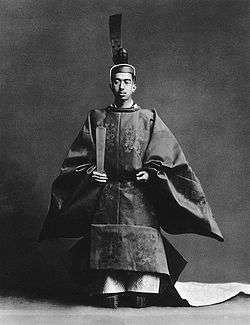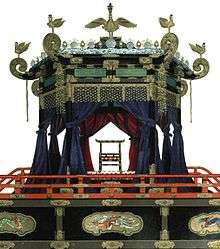Enthronement of the Japanese Emperor

The Enthronement (即位の礼 Sokui no rei) of the Emperor of Japan is an ancient ceremony which marks the accession of a new ruler to the Chrysanthemum Throne, in the world's oldest continuous hereditary monarchy. Various ancient imperial regalia are given to the new sovereign during the course of the rite.
The Ceremony
Presentation of the Three Sacred Treasures
The Japanese enthronement ceremony consists of three main parts. The first is the simplest, and takes place immediately after the death of the preceding sovereign. The Heir Apparent is formally presented with boxes containing two of the Three Sacred Treasures of Japan: (1) a replica sword representing the sword Kusanagi-no-Tsurugi (lit. "Grasscutter Sword") (草薙劍), though the original is allegedly enshrined at Atsuta Shrine in Nagoya; and (2) the Yasakani no magatama (八尺瓊曲玉), a necklace of comma-shaped stone beads. Unlike other monarchies, Japan has no crown in its regalia. These three objects were originally said to have been given by the Sun Goddess, Amaterasu-ōmikami, to her grandson when he first descended to earth and became the founder of the imperial dynasty. The most important of these three treasures is the mirror Yata no Kagami (八咫鏡), which is enshrined in the Ise Shrine as the go-shintai (御神体), or the embodiment of the Sun Goddess herself. It is permanently housed in the shrine, and is not presented to the Emperor for the enthronement ceremony. Imperial messengers and priests are sent to this shrine, as well as to the tomb-shrines of the four Emperors whose reigns immediately preceded his, to inform them of the new Emperor's accession.
Enthronement


The second part of the ceremony, called the "Sokui-Rei", is the enthronement ritual itself; the last such ceremony was held in 1990 for the current sovereign, Akihito. This ancient rite was traditionally held in Kyoto, the former capital of Japan, but in 1990, Emperor Akihito was enthroned in Tokyo. The 1990 enthronement was the first to be covered on television, and have Imperial Guards in traditional uniforms. It was done indoors, with the elevated stand placed inside the Imperial Palace complex. Only part of the ritual is public, and the regalia itself is generally seen only by the Emperor and a few Shinto priests. An account in Time magazine from the enthronement of Emperor Akihito's father Hirohito in 1928 reveals a few details: First came a three-hour ceremony in which the new Emperor ritually informed his ancestors that he had taken the throne. This was followed by the enthronement itself, which took place in an enclosure called the Takamikura, containing a great square pedestal upholding three octagonal pedestals topped by a simple chair. This was surrounded by an octagonal pavilion with curtains, surmounted by a great golden Phoenix.[1] At the same time, the Empress of Japan, in full dress regalia, moved to a separate pedestal beside her husband's. Traditional drums were, at this point of the ceremony, beaten to start the proceddings,
The new Emperor proceeded to the chair, where after being seated, the Kusanagi, Yasakani no magatama, privy seal and state seal were placed on stands next to him. A simple wooden sceptre was presented to the Emperor, who faced his Prime Minister standing in an adjacent courtyard, representing the Japanese people. The Emperor offered an address announcing his accession to the throne, calling upon his subjects to single-mindedly assist him in attaining all of his aspirations. His Prime Minister replied with an address promising fidelity and devotion, followed by a "three cheers of Banzai" from all of those present. The timing of this last event was precisely synchronized, so that Japanese around the world could join in the "Banzai" shout at precisely the moment that it was being offered in Kyoto or in Tokyo.[1]
This moment of the rite ends with the firing of a 21-gun salute by the Japan Self-Defense Force.
The Daijo-sai
The Daijo-sai, or the Great Thanksgiving Festival, is the third and most important—and also the most controversial of the inauguration rituals, because it is the one in which the Emperor is united to his Imperial Ancestress, sun-goddess Amaterasu-ōmikami, in such a way as to share in a unique way in her divinity. The ceremony is not mentioned in the Constitution imposed by the American occupation forces, and so its present constitutionality was questioned at the time of the accession of the present Emperor Akihito.
First, two special rice paddies are chosen and purified by elaborate Shinto purification rites. The families of the farmers who are to cultivate the rice in these paddies must be in perfect health. Once the rice is grown and harvested, it is stored in a special Shinto shrine as its goshintai (御神体), the embodiment of a kami or divine force. Each kernel must be whole and unbroken, and is individually polished before it is boiled. Some sake is also brewed from this rice.
Meanwhile, two thatched roof two-room huts are built within a corresponding special enclosure, using a native Japanese building style which predates and is thus devoid of all Chinese cultural influence. One room contains a large couch at its center; the second is used by musicians. All furniture and household items also preserve these earliest, and thus most purely Japanese forms: e.g., all pottery objects are fired but unglazed. These two structures represent the house of the preceding Emperor and that of the new Emperor. In earlier times, when the head of a household died his house was burned; before the founding of Kyoto, whenever an Emperor died his entire capital city was burned as a rite of purification.
After a ritual bath, the Emperor is dressed entirely in the white silk dress of a Shinto priest, but with a special long train. Surrounded by courtiers, the Emperor solemnly enters first the enclosure and then each of these huts in turn and performs the same ritual—from 6:30 to 9:30 PM in the first, and in the second from 12:30 to 3:30 AM on the same night. A mat is unrolled before him and then rolled up again as he walks, so that his feet never touch the ground. A special umbrella is held over the sovereign's head, in which the shade hangs from a phoenix carved at the end of the pole and prevents any defilement of his sacred person coming from the air above him. Kneeling on a mat situated to face the Grand Shrine of Ise, the Emperor makes an offering of the sacred rice, the sake made from this rice, millet, fish and a variety of other foods from both the land and the sea, to Amaterasu. Then he eats some of this sacred rice himself, as an act of divine communion which consummates his singular unity with Amaterasu-ōmikami, thus making him (in Shinto tradition) the intermediary between Amaterasu and the Japanese people.[2][3] This is followed by three banquets and a visit to the Shrines of his Imperial Ancestors.[1]
See also
- Coronation of the British monarch, the analogous ritual in the United Kingdom
- Inauguration of the Dutch monarch in the Netherlands
- Installation of the Yang di-Pertuan Agong in Malaysia
- Papal inauguration in Vatican City State
References
- 1 2 3 "Emperor Enthroned – TIME". Time.com. November 19, 1928. Retrieved 2008-10-12.
- ↑ Schoenberger, Karl (November 23, 1990). "Akihito in Final Ritual of Passage". Los Angeles Times. Retrieved 2010-05-02.
- ↑ Weisman, Steven R. (November 23, 1990). "Akihito Performs His Solitary Rite". The New York Times. Retrieved 2010-05-02.
Further reading
- Robert S. Ellwood, The Feast of Kingship: Accession Ceremonies in Ancient Japan (Tokyo: Sophia University, 1973).
- D. C. Holtom, Japanese Enthronement Ceremonies: With an Account of the Imperial Regalia (Tokyo: Sophia University, 1972).